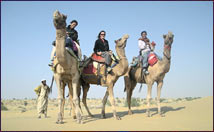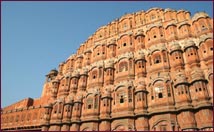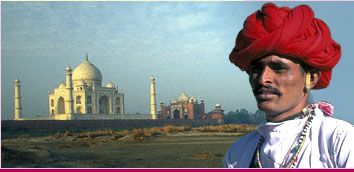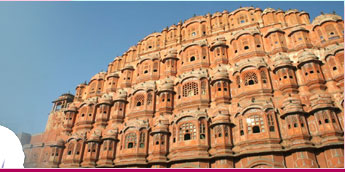Heritage of Jaipur
 The
sovereign of Amber, built Jaipur in the eighteenth century. It was
also around that time that the Mughal Emperor Aurangzeb had died and
the decline of the Mughal Empire had set in. Jai Singh had started
distancing himself from the affair of the Mughal Court and he began
concentrating on building of Amber. His search for a safe place for
the increasing population of Amber resulted in Jaipur, This was
India's first planned city and a brilliant architect Vidyadhar
Bhattacharya from Bengal was commissioned to plan the city. He
designed it in accordance with ancient Hindu treatise on
architecture, the Shilpa Shastra (Vaastu).
The
sovereign of Amber, built Jaipur in the eighteenth century. It was
also around that time that the Mughal Emperor Aurangzeb had died and
the decline of the Mughal Empire had set in. Jai Singh had started
distancing himself from the affair of the Mughal Court and he began
concentrating on building of Amber. His search for a safe place for
the increasing population of Amber resulted in Jaipur, This was
India's first planned city and a brilliant architect Vidyadhar
Bhattacharya from Bengal was commissioned to plan the city. He
designed it in accordance with ancient Hindu treatise on
architecture, the Shilpa Shastra (Vaastu).Jaipur was planned in a gird system with wide straight avenues, roads, streets and lanes and uniform rows of shops on either side of the main roads, all arranged in nine rectangular city sectors (chokdis). The city is surrounded by a wall having seven gates and was built for protection from invading armies and wild animals that lurked just outside in the jungles that surrounded the city. But Jai Singh's planned city has withstood all the pressures and the changes.
ROMANCE OF PINK CITY - Jaipur needed a fresh coat of paint to welcome its distinguished guest the Prince of Wales in 1905-6. The contractor inability to supply any other color in the required quantity compelled the choice of pink shade for its walls. A contractor's compulsion famed Jaipur to Pinkcity. Since then the PINK color is associated with hospitality in Rajput culture.
Jaipur has a timeless appeal in its colorful bazaars that delights for its Rajasthani handlooms and trinkets. Beautifully laid out gardens and parks, attractive monuments and marvelous heritage hotels, once the residence of Maharajas, are worth admiration, not to mention the ambling camels and cheerful people in multi hued costumes that make Jaipur a tourist's paradise.
How to Reach Jaipur
Air : Indian Airlines connect Jaipur with Delhi, Jodhpur, Udaipur, Aurangabad, Bombay, Varanasi, Calcutta, Ahmedabad
Rail: Jaipur is connected by rail with Delhi, Agra, Ahmedabad, Ajmer, Abu Road (Mount Abu), Udaipur, Bombay and Sawai Madhopur
Road: Good motorable roads connect Jaipur with Delhi 258 km, Agra 236 km, Bikaner 321 km, Udaipur 405 km, Ajmer 131 km, Jodhpur 316 km, Bharatpur 176 km, Jaisalmer 638 km and Bombay 1202 km
Bus : Regular buses ply from Jaipur to the above places and Alwar, Kota, Sariska, Mathura, Indore, Chittorgarh and Barmer.
Places of Interest in Jaipur
HAWA MAHAL
 built
in 1799, by Maharaja Sawai Pratap Singh, is the most recognizable
monument of Jaipur. The 5 storied stunning semi-octagonal monument
having 152 windows with over hanging latticed balconies is a fine
piece of Rajput architecture. Originally designed for the royal
ladies to watch and enjoy the processions and other activities, on
the street below. Now it houses a well laid out museum. The display
"Jaipur past and present" is the special feature of this
newly setup museum.
built
in 1799, by Maharaja Sawai Pratap Singh, is the most recognizable
monument of Jaipur. The 5 storied stunning semi-octagonal monument
having 152 windows with over hanging latticed balconies is a fine
piece of Rajput architecture. Originally designed for the royal
ladies to watch and enjoy the processions and other activities, on
the street below. Now it houses a well laid out museum. The display
"Jaipur past and present" is the special feature of this
newly setup museum.Timing 10.00 to 16.30 hrs,
JANTAR MANTAR (Observatory) - built in 18th century by Maharaja Sawai Jai Singh II, the huge masonary instruments were used to study the movement of constellations and stars in the sky. Enormous sun-dial still provide accurate time, which are subject to daily corrections.
Timing 9.00 to 16.30 hrs
CITY PALACE AND S.M.S. II MUSEUM - situated in the heart of the old City, it occupies about one seventh of the old city area. The palace is a blend of Rajput and Mughal architecture, it houses a Seven storeyed Chandra Mahal in the centre, which affords a fine view of the gardens and the city. Diwan-E-Am (Hall of public audience) has intricate decorations and collection of manuscripts, Diwan-E-Khas (Hall of private audience) has a marble pawed gallery Mubarak Mahal has a rich collection of costumes and textiles. There is a Clock Tower near Mubarak Mahal. Sileh Khana has a collection of armory and weapons.
Timing 9.30 to 16.45 hrs.
ISHWAR LAT
"Swarg Suli" or 'heaven piercing minaret', the tower, near Tripolia gate, built by Maharaja Ishwari Singh (1744-51). It offers one of the most breathtaking view of the city.
CENTRAL MUSEUM - situated in the Ram Niwas Garden. This graceful building was founded in 1876 by Prince Albert (also known as Albert Hall). It has a rare collection of archaeological and handicraft pieces.
Timing 10.00 to 16.30 hrs
DOLLS MUSEUM - a collection of beautiful dolls from all over the world, it is situated on Jawahar Lal Nehru Marg.
Timing 10.00 to 16.00 hrs
BIRLA PLANETARIUM
It offers unique audio-visual education about stars and entertainment with its modern computerised projection system. Entry fee As. 20.00 show timings: 11.00, 13.00, 15.00, 17.00, 18.00, 19.00 hrs
JALMAHAL
 (6
kms) on the way to Amer, this small palace is set in the middle of
Man Sagar Lake. Renovation around the lake is in progress.
(6
kms) on the way to Amer, this small palace is set in the middle of
Man Sagar Lake. Renovation around the lake is in progress.GAITOR
(6 kms) At the foot hill of Nahargarh stands the memorials to the former rulers of Jaipur the place has some gracefully carved cenotaphs in white marble.
JAIGARH FORT
(15 kms.) standing on a hilltop, overlooking the palaces and city of Amer. The world's biggest cannon on wheels- the Jai Ban is positioned here, built during reign of Maharaja Sawai Jaisingh. It has a twenty feet long barrel and pumped in the cannon for a single shot. Timing 10.00 to 16.45 hrs
NAHARGARH FORT
(15 kms.) cresting a hill about 600 ft. above the city, the fort was built in 1734. The walls of the fort run along the ridge and within are architectural beauties like Hawa Mandir and Madhvendra Bhawan. Timing 10.00 to 16.00 hrs
GALTA
(10 kms.) This holy pilgrimage centre has a temple dedicated to the Sun God (Which is the only one of its kind in this part of the country) and natural spring. It crests the ridge over a picturesque gorge and provides an impressive view of the city. As the legend goes, sage Galav performed a difficult penance here.
MOTIDOONGARI
perched on a hill top on the southern horizon. It is a replica of a Scottish castle.
LAXMI NARAYAN TEMPLE
is situated just below the Moti 000ngri, known for the intricate marble carvings in white marble, popularly known as Birla Temple.
MAHARANI K! CHHATRI
The funeral place for the royal ladies, marked by some wonderfully carved cenotaphs.
SISODIA RANI GARDEN
(5 kms.) on the road to Agra, the magnificent palace garden was built by Maharaja Sawai Jai Singh II in 1710 for his queen. Timings 8.00 to 18.00 hrs
GARDEN
(5 kms.) on the way to Agra, built by Viyadhar, the chief architect and town planner of Jaipur. This beautiful terraced garden has several galleries and pavilions decorated with exquisite murals, depicting Lord Krishna. Timing 9.00 to 18.00 hrs
KANAK VRINDAVAN
(6.5 Kms on the way to Amer) This newly restored temple and garden, near Jal Mahal, has beautiful gardens and is popular picnic place. This is also beautiful location for film shooting. Entry fee Rs. 4.00 & Timings 8.00 to 17.00 hrs
AMER
The old capital of the Kachhwahas stands atop a range of craggy hills. The fort is remarkable as much for the majestic grandeur of its surroundings as for its sturdy battlements and beautiful palaces. It is a fine blend of Hindu and Muslim architecture. The solemn dignity of it red sandstone and white marble pavilions, when reflected in the lake at the foot hill, is a sight to behold. The original palace was built by Raja Man Singh, the additional extensions were built by Maharaja Mirja Raja Jai Singh and Sawai Jai Singh lIthe last Maharaja of Amer, who built a new city called Jaipur, where he shfted his capital in 1727.
The palace complex is lavishly ornamented and displays the riches of Amer. Sheesh Mahal chamber of Mirrors. Diwan-e-Am or the Hall of Public Audience is a beautifully proportioned hall open on three sides and stands on two rows of ornamented pillars. Diwan e-Khas or the Hall of Private Audience has delicate mosaic work in glass. Sukh mandir is guarded by sandalwood doors inlaid with ivory. Throughout the massive fort finely carved lattice windows, exquisitely painted doorways, halls and finely sculptured pillars crave for attention.





